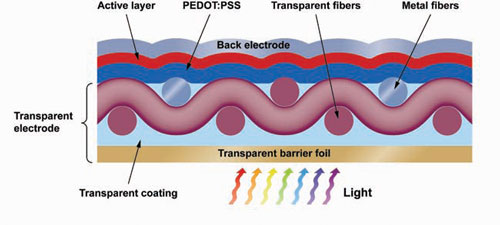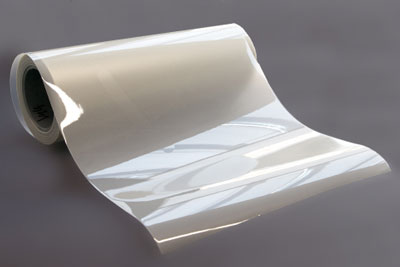| Posted: Apr 04, 2011 | |
Catching sun rays with woven electrodes |
|
| (Nanowerk Spotlight) Transparent conductive coatings are critical components of optoelectronic devices and they pervade modern technology. The most widely used standard coating is indium tin oxide (ITO), used in nearly all flat panel displays and microdisplays. Of increasing concern for manufacturers is Indium's scarcity and high price (geologists say the cost of indium may not matter soon, because the earth's supply of this element could be gone anyway within just a few years) – making the material's use in large-area applications like solar cells uneconomical. Other fabrication issues are ITO's brittleness (making it unsuitable for flexible device applications) and the incompatibility of its fabrication process (vacuum-coating, high-temperature annealing) with plastic-based substrates. | |
| In order to find replacement materials for ITO, scientists have been working with carbon nanotubes (see: "Conductive and tunable transparent coatings made from monodisperse carbon nanotubes"), graphene (see "Solar cells made of carbon only are becoming a possibility"), and other nanoscale materials such as nanowires. While many of these approaches work fine in the lab, upscaleability usually has been an issue. | |
| Researchers at Empa, the Swiss Federal Laboratories for Material Science and Technology, have now demonstrated another solution: they presented a transparent and flexible electrode based on a precision fabric with metal and polymer fibers woven into a mesh. | |
| "Previously, we have reported the concept of using a woven fabric as electrode for organic solar cells, but found that the porous mesh structure led to device fabrication problems and a limited cell efficiency," Roland Hany, who leads the group "Organic Solar Cells" at Empa's Laboratory for Functional Polymers, tells Nanowerk. "In our new work, we have now filled this woven mesh with an inert and transparent polymer in such a way that the polymer completely covers one side of the fabric while the metal wires are still exposed to air at the other side, but for a few micrometers at most. This resulted in a smooth, flexible conductor with a light transmission comparable to that of ITO." | |
 |
|
| Schematic side view of an organic solar cell including woven, transparent fabric electrode, active layers (PEDOT:PSS and P3HT/PCBM), and the aluminium back electrode. (Reprinted with permission from Wiley-VCH Verlag) | |
| The result is a transparent and flexible electrode based on a precision fabric with metal and polymer fibers woven into a mesh. The findings have been published in a recent issue of Advanced Materials ("Woven Electrodes for Flexible Organic Photovoltaic Cells"). | |
| The team demonstrated organic solar cells fabricated on their flexible precision fabrics as well as on conventional glass/ITO substrates and found very similar performance characteristics. | |
| The Empa Team worked with a commercial partner, Sefar AG, a company that is specialized in the production of precision fabrics that are used for filtration processes or screen-printing applications. | |
| "The application of precision fabrics to flexible optoelectronics nicely complements the core technology of Sefar AG" says Hany. "It is a principle advantage of the woven substrate electrode that we demonstrated that its fabrication has already been fully implemented into a technological roll-to-roll process, thanks to Sefar's know-how." | |
| As they discuss in their paper, the woven mesh electrode fabricated by Sefar is flexible, highly transparent and the current can be extracted over sizes relevant to photovoltaics (several centimeters); in addition, the fabric is already now produced by a roll-to-roll process (running speed 10 meters per minutes), and therefore allows the production of very large electrode area. | |
| The woven electrodes are already very transparent because the fabric is made of threads less than 40 micrometer in diameters woven in a way that produces large openings. The electrode is also very flexible, lightweight, has a long lifetime and a high tolerance towards bending. | |
 |
|
| A roll (1 meter wide, 100 meters long) of woven precision fabric. (Image: Sefar AG) | |
| Hany notes that in the actual solar cell, light is reaching the active layer through the fabric electrode side. "Therefore, the use of an open mesh is beneficial, which means thin fibers and large metal wire distances. We used 76% open fabrics, where we define the opening percentage by the ratio between the transparent area (polymer-filled holes) and the geometrical area of the electrode. In addition to direct light transmission, the fabrics considerably scatter light in the forward direction." | |
| The team points out that the woven electrode can be improved by optimizing the filling process of the mesh openings, such that the distance between the exposed metal wires and the polymer filling is further reduced. | |
| "It is essential that the metal wires are exposed to the air just by a few microns at most" says Hany. "For larger distances, the first coating of the photovoltaic active materials needs to be made rather thick, and some light is absorbed in a region of the cells where no electrical charges are generated. So far, Sefar AG was able to minimize the exposure of the metal wires to approx. 10-15 microns." | |
| In the meantime, the researchers are working with new electrodes where this distance has been further reduced to approximately 5 microns – more light is now able to reach the active solar cell material, more charges are thereby produced and the overall device performance improved considerably. They will publish these results soon. | |
 By
Michael
Berger
– Michael is author of three books by the Royal Society of Chemistry:
Nano-Society: Pushing the Boundaries of Technology,
Nanotechnology: The Future is Tiny, and
Nanoengineering: The Skills and Tools Making Technology Invisible
Copyright ©
Nanowerk LLC
By
Michael
Berger
– Michael is author of three books by the Royal Society of Chemistry:
Nano-Society: Pushing the Boundaries of Technology,
Nanotechnology: The Future is Tiny, and
Nanoengineering: The Skills and Tools Making Technology Invisible
Copyright ©
Nanowerk LLC
|
|
|
Become a Spotlight guest author! Join our large and growing group of guest contributors. Have you just published a scientific paper or have other exciting developments to share with the nanotechnology community? Here is how to publish on nanowerk.com. |
|
